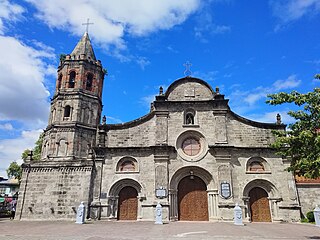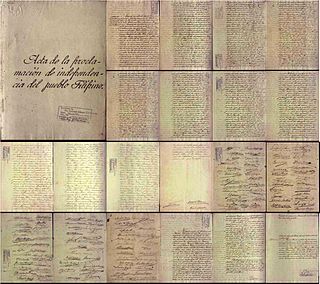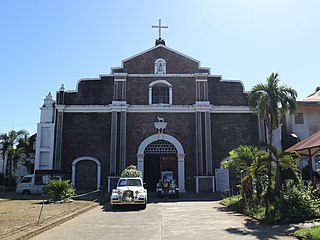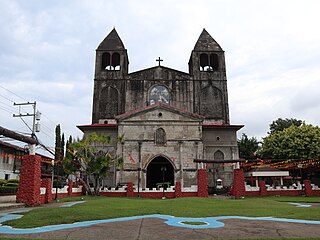
Bulacan, officially the Province of Bulacan, is a province in the Philippines located in the Central Luzon region. Its capital is the city of Malolos. Bulacan was established on August 15, 1578, and part of the Metro Luzon Urban Beltway Super Region.

San Jose del Monte, officially the City of San Jose del Monte, is a 1st class component city in the province of Bulacan, Philippines. According to the 2020 census, it has a population of 651,813 people, making it the largest local government unit within the province of Bulacan and Central Luzon, and the 18th most populated city in the Philippines.

Bulakan, officially the Municipality of Bulakan, is a 1st class municipality in the province of Bulacan, Philippines. According to the 2020 census, it has a population of 81,232 people.

Intramuros is the 0.67-square-kilometer (0.26 sq mi) historic walled area within the city of Manila, the capital of the Philippines. It is administered by the Intramuros Administration with the help of the city government of Manila.

Malolos, officially the City of Malolos, is a 1st class component city and capital of the province of Bulacan, Philippines. According to the 2020 census, it has a population of 261,189 people. It is the capital city of the province of Bulacan as the seat of the provincial government.

The Philippine Declaration of Independence was proclaimed by Filipino revolutionary forces general Emilio Aguinaldo on June 12, 1898, in Cavite el Viejo, Philippines. It asserted the sovereignty and independence of the Philippine islands from the 300 years of colonial rule from Spain.

Balagtas, officially the Municipality of Balagtas, is a 1st class municipality in the province of Bulacan, Philippines. According to the 2020 census, it has a population of 77,018 people. The municipality is 30 kilometers (19 mi) from Manila and is 15 kilometers (9.3 mi) from Malolos City.

The legislative districts of Bulacan are the representations of the province of Bulacan in the various national legislatures of the Philippines. The province is currently represented in the lower house of the Congress of the Philippines through its first, second, third, fourth, fifth and sixth congressional districts.

Molo is a district in Iloilo City, Philippines, located in the province of Iloilo, on the island of Panay in the Western Visayas region. It is the most densely populated district in the city. According to the 2020 census, Molo has a population of 76,393 people, making it the second-most populous district, after Jaro.

Our Lady of Mount Carmel Parish, also known as Barásoain Church is a Roman Catholic church built in 1888 in Malolos, Bulacan, Philippines. It is under the jurisdiction of the Diocese of Malolos and is about 42 kilometers (26 mi) from Manila. Having earned the title as the "Cradle of Democracy in the East, the most important religious building in the Philippines", and the site of the First Philippine Republic, the church is proverbial for its historical importance among Filipinos.
Bulacan is a province of the Philippines. It was established on 15 August 1578.

The Philippine Registry of Cultural Property, abbreviated as PRECUP, is a national registry of the Philippine Government used to consolidate in one record all cultural property that are deemed important to the cultural heritage, tangible and intangible, of the Philippines. On June 11, 2018, the entries in the newly updated PRECUP was at 3,921. Additionally, 1,259 out of 1,715 LGUs, or 73 percent of LGUs have established local cultural inventories (LCI).

Saint Augustine Parish Church, commonly known as Paoay Church, is a Roman Catholic church in the municipality of Paoay, Ilocos Norte in the Philippines. It is under the jurisdiction of the Diocese of Laoag. Completed in 1710, the church is famous for its distinctive architecture, a highlight of which is the enormous buttresses on the sides and back of the building. It is declared as a National Cultural Treasure by the Philippine government in 1973 and a UNESCO World Heritage Site under the collective group of Baroque Churches of the Philippines in 1993.

Ancestral houses of the Philippines or Heritage Houses are homes owned and preserved by the same family for several generations as part of the Filipino family culture. It corresponds to long tradition by Filipino people of giving reverence for ancestors and elders. Houses could be a simple house to a mansion. The most common ones are the "Bahay na Bato". Some houses of prominent families had become points of interest or museums in their community because of its cultural, architectural or historical significance. These houses that are deemed of significant importance to the Filipino culture are declared Heritage House by the National Historical Commission of the Philippines (NHCP), previously known as the National Historical Institute (NHI) of the Philippines. Preservation is of utmost importance as some ancestral houses have come into danger due to business people who buy old houses in the provinces, dismantle them then sell the parts as ancestral building materials for homeowners wishing to have the ancestral ambiance on their houses. These ancestral houses provide the current generation a look back of the country's colonial past through these old houses.

Racism in the Philippines is multifarious and emerged in various portions of the history of people, institutions and territories coinciding to that of the present-day Philippines.

The Uitangcoy-Santos House is an early 20th-Century bay-na-bato structure along FT Reyes Street in Barangay Sto. Nino, in the city of Malolos, Bulacan, in the Republic of the Philippines. The home belonged to Paulino Santos—a Propetario and Cabeza de Barangay, and Alberta Uitangcoy-Santos—who was the leader of The Women of Malolos, and is revered for her contributions to Philippine women's rights, the fight for Philippine independence, and a large part of Malolos' traditional cuisine during the Spanish and American colonial periods. The Uitangcoy-Santos House has been declared a national heritage house by the National Historical Commission of the Philippines, and is currently a privately owned museum that houses four exhibit halls and a lecture hall. The museum currently showcases collections of surviving artifacts and other memorabilia relevant to the narrative of the women and the Uitangcoy-Santos family.

Saint Andrew the Apostle Parish, commonly known as Bacarra Church, is a Roman Catholic church located in the municipality of Bacarra, Ilocos Norte, Philippines under the jurisdiction of the Diocese of Laoag.

The Pila Historic Town Center is a historic district located at Barangay Santa Clara Norte, Pila, Laguna, Philippines. The district preserves examples of Spanish and American-era architecture found in its town proper laid out with the Spanish colonial town planning system for the Indies and is also a pre-Hispanic archaeological site. The National Historical Institute declared a specific portion of Pila as a National Historical Landmark in 2000. The town has been recognized by scholars as a possible contender in UNESCO as a world heritage site.

The Dapitan Heritage Zone or Dapitan Historic Center is a declared historic district in Dapitan, Philippines. Because of its prehistoric origins, collection of heritage structures and role in the exile of local patriot Dr. Jose Rizal, the National Historical Commission of the Philippines declared a specific portion of the city, along with its heritage structures, as a Heritage Zone or Historic Center in 2011. The declaration was made in coordination with the 150th birth anniversary of Dr. Rizal in June 2011.
Alberta Uitangcoy-Santos was the leader of The Women of Malolos, and is revered for her contributions to Philippine women's rights, the fight for Philippine independence, and a large part of the traditional cuisine of the city of Malolos, Bulacan, in the Philippines during the Spanish and American colonial periods. She is known as the matriarch of the Uitangcoy-Santos House, which has been declared a national heritage house by the National Historical Commission of the Philippines, and currently houses the Museum of the Women of Malolos which is now curated by her fifth-generation grandson, Carlo Herrera.























































